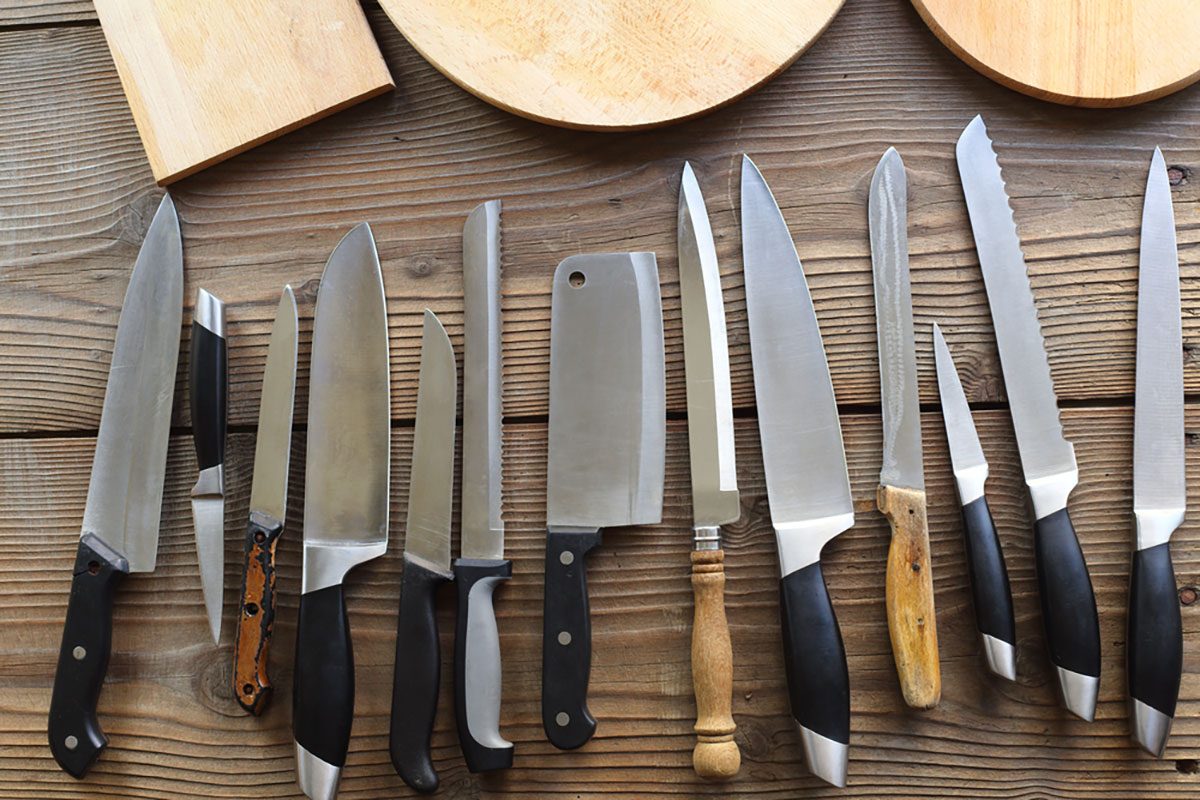From the wrong cutting boards to improper sharpening to the dreaded dishwasher, here are some of the most common mistakes that are dulling and damaging kitchen knives.

8 Ways You’re Abusing Your Kitchen Knives Without Knowing It

Gadgets come and go, but kitchen knives are among the home cook’s most valuable tools. With the right few in your arsenal, you can handle everything from chopping and mincing to carving a chicken and peeling a mango (just make sure you’re holding your knife the right way!). A good-quality knife will last a lifetime—provided you don’t abuse it.
Mistake No. 1: Leaving the Knife in the Sink
It’s sloppy to leave dishes in the sink, but letting loose knives pile up is even worse. Not only is it dangerous for the next person who washes the dishes, but the blades can also get scratched, and tips can get bent or even broken. Imagine a heavy cast-iron Dutch oven banging down on top of your precious knife.
The solution: Wash knives immediately after use. If you have to wait, leave them on the countertop where you won’t forget about them.
Mistake No. 2: Washing It Improperly
The dishwasher is a time-saving modern marvel. But it’s a definite no-go when it comes to your knives. Blades can be scratched by other utensils during the wash cycle, chemicals in the detergent can cause pitting or discoloration, and a high-heat drying cycle can even cause warping.
The solution: Wash your knives by hand in hot water with a soft sponge and gentle dish soap immediately after use. And be sure to dry your knives with a clean towel directly after washing; moisture left on a blade can equal mold on or around the handle or, depending on what the blade is made of, rust.
Mistake No. 3: Letting the Knife Get Dull
A dull blade can actually be more dangerous than a sharp one, because it’s more likely to slip. If a knife slides across the surface of a tomato or onion before cutting in, you know it’s time to be sharpened.
The solution: Plan on sharpening your blade every six to 12 months, and honing it in between.
Mistake No. 4: Using the Wrong Tools
If you read the last tip and wondered what the difference was between sharpening and honing, chances are you might not be treating it right, even if you sharpen it regularly. Home sharpeners—electric ones and the nifty double-bladed grooved type—are ripe for abuse, as they can easily strip away too much metal or sharpen unevenly, both of which can lead to chipping and breakage.
The solution: Use the proper sharpening and honing tools, and learn to use them the right way. However, don’t worry if you’re not an expert. Many kitchen-supply stores and hardware stores offer professional knife-sharpening services. Also check online for a knife specialist in your area. It’s not expensive, and it’s worth the time and effort to have the job done right.
Mistake No. 5: Storing Knives Improperly
Keeping your knives in a kitchen drawer, where they can bang up against other utensils, can damage the blades—as well as pose a hazard to anyone reaching into the drawer. Knife blocks are pretty and space-efficient, but grease and dirt can get trapped deep inside them and then transfer to your knife blade.
The solution: The best way to store your knife is on a magnetized board—it’s a space-saver, too (and here are 12 more). If you use a knife block, be sure to keep it clean. If you must store your knives in a drawer, buy some plastic knife guards to slide over the blades when not in use.
Mistake No. 6: Using the Wrong Cutting Board
Any cutting board or countertop that’s hard enough not to be damaged by a knife—granite, concrete, marble, glass, hardened acrylic—is hard enough to damage the knife. Think of it this way: Something’s gotta give, and you don’t want it to be your knife. (The verdict is still out on bamboo.)
The solution: Always use a cutting board, and stick with traditional hardwood as the best first choice. Plastic boards are gentle on the knife blade, but gouges left by the blade can provide a home for bacteria. So if you go the plastic route, be sure to disinfect the board thoroughly after use.
Mistake No. 7: Cutting Incorrectly
We all love the “chop-chop-chop” sound knives makes against the cutting board. But check the volume of that sound. Chopping is not a high-impact sport. If your knife is sharp, you shouldn’t have to work that hard.
The solution: Use a rocking motion to cut, keeping the knife tip in contact with the board as much as possible (this also reduces the odds of injury). And don’t scrape the edge of your blade across the board. If you want to use your knife to gather up that lovely little pile of freshly minced garlic, use the back of the blade.
Mistake No. 8: Using Your Knives for Odd Jobs
A chef’s knife is impressive—whether you’re talking an 8-inch or a 10-inch blade. And it’s tempting to use it for something other than its intended purpose. Do not, for example, use a chef’s knife to cut through chicken bones or frozen foods. If you ever find yourself sawing with your chef’s knife, stop immediately and choose a different tool. And as tempting as the pointy, delicate end of your paring knife may be, do not use it as a screwdriver!
The solution: Choose the right tool for the right job, always.



















